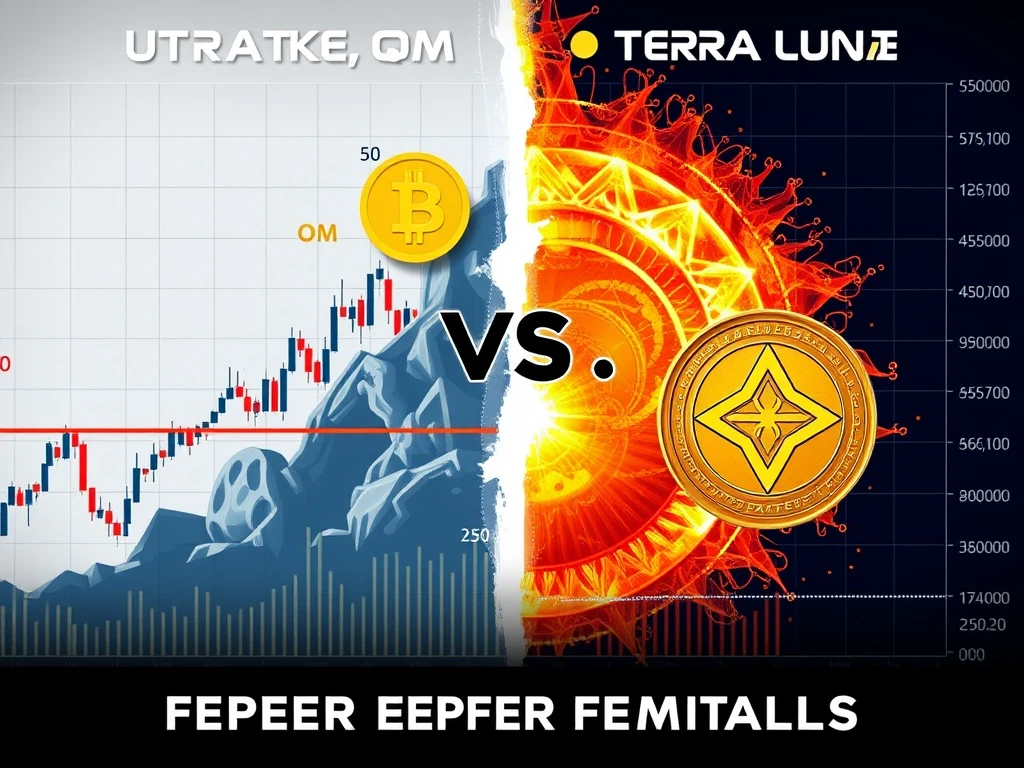Mantra’s Shocking Token Crash: Is It the New Terra Luna? Experts Reveal the Truth

The cryptocurrency world was recently shaken by the dramatic crash of the Mantra (OM) token, sending ripples of concern through the market. Immediately, whispers and worries of another Terra Luna incident began to surface, fueled by the visual resemblance of the price charts. Was this another algorithmic stablecoin implosion waiting to happen? Many in the crypto community quickly jumped to compare Mantra to the infamous Terra Luna collapse of May 2022. But are these comparisons valid, or are we seeing a case of mistaken identity in the volatile world of crypto?
Is the Mantra Token Crash a Repeat of the Terra Luna Disaster?
While the knee-jerk reaction to compare the Mantra token crash to Terra Luna is understandable, especially given the sharp and sudden price drop, experts in the DeFi space urge caution. According to Ben Yorke, VP of Ecosystem at Woo, and Alexis Sirkia, Chairman of Yellow Network, the similarities are superficial at best. Both agree that looking beyond the price charts reveals fundamentally different scenarios.
Yorke stated, “While it’s tempting to draw parallels between OM’s recent crash and the Terra Luna collapse, they’re fundamentally very different events.” Sirkia echoed this sentiment, emphasizing, “There are no real similarities apart from the visual of the price dropping.”
Visual Similarities, Different Realities: Comparing the Crashes
Let’s break down the numbers to understand why the visual similarities are misleading:
- Mantra (OM) Crash: On April 13th, the OM token plummeted a staggering 92% in just hours, dropping from over $6 to around $0.52. This rapid descent resulted in a $5.4 billion market capitalization loss in under four hours.
- TerraClassicUSD (USTC) Crash: In contrast, the TerraClassicUSD (formerly UST) crash, while devastating, unfolded over a longer period. It took five days for USTC to lose a similar percentage, shedding a massive $17.2 billion.
The following chart visually represents the contrasting timelines of the cryptocurrency crashes:
Mantra’s OM crash in April 2025 versus USTC (formerly UST) crash in May 2022 (seven-day chart). Source: CoinGecko
Furthermore, the original LUNA crash began even before UST depegged, indicating a more systemic issue within the Terra ecosystem. While the price chart visuals might trigger alarm bells and evoke memories of the Terra debacle, the underlying causes and project structures are vastly different.
Terra Luna’s Systemic Flaw vs. Mantra’s Market Correction
The core distinction lies in the nature of the collapses. Experts like Yorke and Sirkia highlight that Terra’s downfall was deeply rooted in a systemic flaw – the failure of its algorithmic stablecoin, UST. Mantra, on the other hand, hasn’t been linked to any such inherent structural weaknesses.
Yorke suggests, “OM appears to be more of a case of mismanagement or negligence.” He points to the suspicious movement of a “large number of insider-held tokens” to exchanges, which likely triggered a cascade of liquidations and fueled the dramatic price drop. This perspective is supported by on-chain analyst ZachXBT’s findings.
Source: ZachXBT
“The issue wasn’t a structural flaw in the protocol, but rather a breakdown in token handling and trust,” Yorke clarified. This points to a market structure problem rather than a fundamental protocol failure, a crucial difference from the Terra situation.
Why Mantra is Not “Broken” Like Terra Luna
Sirkia emphatically stated, “Mantra is not broken. There was no peg to fail. This is a market structure issue, not a protocol failure.” He emphasized that only a critical smart contract failure would indicate a genuine protocol problem.
He further elaborated on the fundamental difference:
- Terra Luna’s Collapse: Caused by inherent flaws in its algorithmic stablecoin mechanism.
- Mantra’s Correction: Driven by market dynamics and token handling issues, not a protocol breakdown.
Sirkia also pointed to Mantra’s transparency post-crash and the subsequent 200% price rebound as indicators of underlying community belief and demand – something notably absent during Luna’s collapse. “After the drop, OM bounced over 200%, showing real demand and community belief. That kind of recovery never happened with Luna.”
Mantra’s Path Forward: Recovery and Transparency
As of the second day following the Mantra crash, the OM token has shown signs of recovery, climbing back to around $0.80 after the initial plunge to $0.50. This nascent recovery suggests a degree of market confidence remains in the project’s fundamentals, despite the recent turmoil.
Mantra CEO John Mullin has acknowledged the severity of the situation, stating that OM token recovery is the “primary concern.” He has also committed to releasing a post-mortem report within 24 hours detailing the events that led to the crash. This commitment to transparency is a positive step towards rebuilding trust within the community.
Key Takeaways: Mantra vs. Terra Luna
To summarize, while the visual similarities between the Mantra and Terra Luna price crashes are undeniable, the underlying causes and the nature of the projects are vastly different. Here’s a quick comparison:
| Feature | Mantra (OM) Crash | Terra Luna (UST) Collapse |
|---|---|---|
| Cause | Market structure issue, potential token mismanagement | Systemic flaw in algorithmic stablecoin |
| Protocol Failure | No | Yes |
| Recovery Potential | Showing signs of recovery | Minimal to none after initial collapse |
| Transparency Post-Crash | CEO committed to post-mortem report | Lack of transparency and accountability |
In conclusion, while any significant DeFi token crash is a cause for concern and warrants careful investigation, it’s crucial to avoid hasty comparisons. The Mantra situation appears to be a painful but potentially recoverable market correction, distinct from the systemic and catastrophic failure of Terra Luna. The coming days will be critical for Mantra as they work towards recovery and restoring community trust through transparency and decisive action.









